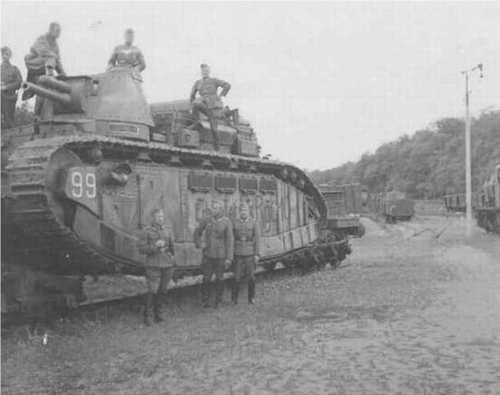
French Forces
Heavy tank FCM 2C nr. 99, “Champagne”
The Char 2C (FCM 2C) had a loaded weight of 69 tonnes, partly because of its armour - 45 mm at the front, 22 mm at the sides, but much of it just because of its huge size. It is still easily the largest tank ever taken into production. With the tail fitted, the hull was over twelve metres long. Within its ample frame there was room for two fighting compartments. The first at the front, crowned by a three-man turret (the first in history) with a long 75 mm gun, and the second at the back, topped by a machine gun turret. The three independent 7.92 mm machine gun positions at the front gave protection against infantry assault. The fighting compartments were connected by the engine room. Each track was powered by its own 200 or 250 hp engine, via an electrical transmission. Top speed was 15 km/h. Seven fuel tanks, containing 1,260 litres, gave it a range of 150 kilometres. To man the tank required a crew of twelve: driver, commander, gunner, loader, four machine gunners, mechanic, electrician, assistant-electrician/mechanic and a radio operator. There were 10 FCM 2C in the 51st Bataillon de Chars de Combat. For propaganda, each tank had been named after one of the ancient regions of France, numbers 90-99 named Poitou; Provence; Picardie; Alsace; Bretagne; Touraine; Anjou; Normandie; Berry; Champagne respectively. They were used for numerous morale-boosting movies, climbing and crushing old French forts instead. When the German Panzerdivisionen in the execution of Operation Fall Rot ripped apart the French lines after 10 June 1940, the decision was made to prevent the capture of the famous equipment. It was to be sent to the south by rail transport. On 15 June the rail was blocked by a burning fuel train, so it became inevitable to destroy the tanks by detonating charges. Later Goebbels and Goering claimed the tanks were hit by German dive bombers. This propaganda lie was to be repeated by many sources. The charge of the Champagne failed to destroy the tank, and it was captured more or less intact and sent to Berlin to be exhibited as a war trophy. In 1948 this tank disappeared, causing many to speculate it still survives at the Russian Tank museum in Kubinka. (Sources: Wikipedia - www.char-francais,net)
4317 Views
10/19/2010
